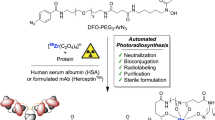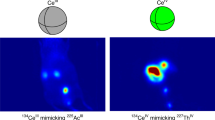Abstract
IRDye800CW and zirconium-89 (89Zr) have very attractive properties for optical imaging and positron emission tomography (PET) imaging, respectively. Here we describe a procedure for dual labeling of mAbs with IRDye800CW and 89Zr in a current good manufacturing practice (cGMP)-compliant way. IRDye800CW and 89Zr are coupled inertly, without impairment of immunoreactivity and pharmacokinetics of the mAb. Organ and whole-body distribution of the final product can be assessed by optical and PET imaging, respectively. For this purpose, a minimal amount of the chelate N-succinyldesferrioxamine (N-sucDf) is first conjugated to the mAb. Next, N-sucDf-mAb is conjugated with IRDye800CW, after which the N-sucDf-mAb-IRDye800CW is labeled with 89Zr. After each of these three steps, the product is purified by gel filtration. The sequence of this process avoids unnecessary radiation exposure to personnel and takes about 5 h. The process can be scaled up by the production of large batches of premodified mAbs that can be dispensed and stored until they are labeled with 89Zr.
This is a preview of subscription content, access via your institution
Access options
Subscribe to this journal
Receive 12 print issues and online access
$259.00 per year
only $21.58 per issue
Buy this article
- Purchase on Springer Link
- Instant access to full article PDF
Prices may be subject to local taxes which are calculated during checkout




Similar content being viewed by others
References
Van Dongen, G.A.M.S. et al. Immuno-PET: a navigator in monoclonal antibody development and applications. Oncologist 12, 1379–1389 (2007).
Van Dongen, G.A.M.S. & Vosjan, M.J.D.W. Immuno-PET: shedding light on clinical antibody development. Cancer Biother. Radiopharm. 25, 375–385 (2010).
Weissleder, R. Molecular imaging: exploring the next frontier. Radiology 212, 609–614 (1999).
Te Velde, E.A. et al. The use of fluorescent dyes and probes in surgical oncology. Eur. J. Surg. Oncol. 36, 6–15 (2010).
Frangioni, J.V. In vivo near-infrared fluorescence imaging. Curr. Opin. Chem. Biol. 7, 626–634 (2003).
Van Dam, G.M. et al. Intraoperative tumor-specific fluorescence imaging in ovarian cancer by folate receptor-α targeting: first in-human results. Nat. Med. 17, 1315–1319 (2011).
Ito, S., Muguruma, N. & Hayashi, S. et al. Development of agents for reinforcement of fluorescence on near-infrared ray excitation for immunohistological staining. Bioorg. Med. Chem. 6, 613–618 (1998).
Kovar, J.L. et al. A systemic approach to the development of fluorescent contrast agents for optical imaging of mouse cancer models. Anal. Biochem. 367, 1–12 (2007).
Terwisscha van Scheltinga, A.G. et al. Intraoperative near-infrared fluorescence tumor imaging with vascular endothelial growth factor and human epidermal growth factor receptor 2 targeting antibodies. J. Nucl. Med. 52, 1778–1785 (2011).
Oliveira, S. et al. Rapid visualization of human tumor xenografts through optical imaging with a near-infrared fluorescent anti-epidermal growth factor receptor nanobody. Mol. Imaging 11, 33–46 (2012).
Marchall, M.V. et al. Single-dose intravenous toxicology study of IRDye800CW in Spraque-Dawley rats. Mol. Imaging Biol. 12, 583–594 (2010).
Verel, I. et al. 89Zr immuno-PET: comprehensive procedures for the production of 89Zr-labeled monoclonal antibodies. J. Nucl. Med. 44, 1271–1281 (2003).
Vosjan, M.J.W.D. et al. Conjugation and radiolabeling of monoclonal antibodies with zirconium-89 for PET imaging using the bifunctional chelate p-isothiocyanatobenzyl-desferrioxamine. Nat. Protoc. 5, 739–743 (2010).
Vugts, D.J., Visser, G.W.M. & Van Dongen, G.A.M.S. 89Zr-PET in the development and application of therapeutic monoclonal antibodies and other biologicals. Curr. Top. Med. Chem. (in the press) (2013).
Borjesson, P.K. et al. Performance of immuno-positron emission tomography with zirconium-89-labeled chimeric monoclonal antibody U36 in the detection of lymph node metastases in head and neck cancer patients. Clin. Cancer Res. 12, 2133–2140 (2006).
Dijkers, E.C. et al. Biodistribution of 89Zr-trastuzumab and PET imaging of HER2-positive lesions in patients with metastatic breast cancer. Clin. Pharmacol. Ther. 87, 586–592 (2010).
Williams, S-P. Tissue distribution studies of protein therapeutics using molecular probes: molecular imaging. AAPS J. 14, 389–399 (2012).
Oliviera, S. et al. A novel method to quantify IRDye800CW-fluorescent antibody probes ex vivo in tissue distribution studies. EJNMMI Res. 2, 50 (2012).
Van Gog, F.B. et al. Monoclonal antibodies labeled with rhenium-186 using the MAG3 chelate: relationship between the number of chelated groups and biodistribution characteristics. J. Nucl. Med. 37, 352–362 (1996).
Pèlegrin, A. et al. Antibody-fluorescein conjugates for photoimmunodiagnosis of human colon carcinoma in nude mice. Cancer 67, 2529–2537 (1991).
Wu, F., Tamhane, M. & Morris, M.E. Pharmacokinetics, lymph node uptake, and mechanistic PK model of near-infrared dye-labeled bevacizumab after IV and SC administration in mice. AAPS J. 14, 252–261 (2012).
Sampath, L. et al. Dual-labeled trastuzumab-based imaging agent for the detection of human epidermal growth factor receptor 2 overexpression in breast cancer. J. Nucl. Med. 48, 1501–1510.
Sampath, L. et al. Detection of cancer metastases with a dual-labeled near-infrared/positron emission tomography imaging agent. Transl. Oncol. 3, 307–317 (2010).
Cohen, R. Inert coupling of IRDye800CW to monoclonal antibodies for clinical optical imaging of tumor targets. EJNMMI Res. 1, 31 (2011).
Acknowledgements
This project was financially supported by the Center for Translational Molecular Medicine, project AIRFORCE number 030-103 and by the European Union FP7, ADAMANT. The publication reflects only the authors' views. The European Commission is not liable for any use that may be made of the information contained herein.
Author information
Authors and Affiliations
Contributions
All authors contributed extensively to the work presented in the paper. R.C., D.J.V., G.W.M.V. and G.A.M.S.v.D. designed the chemical procedures and experiments. R.C. and M.S-.v.W. did all the chemistry, quality analyses and animal experiments that were used as input data for the protocol. Moreover, they also did the administrative work. D.J.V., G.W.M.V. and G.A.M.S.v.D. gave technical support and conceptual advice. R.C., D.J.V., G.W.M.V. and G.A.M.S.v.D. wrote the protocol.
Corresponding author
Ethics declarations
Competing interests
The authors declare no competing financial interests.
Rights and permissions
About this article
Cite this article
Cohen, R., Vugts, D., Stigter-van Walsum, M. et al. Inert coupling of IRDye800CW and zirconium-89 to monoclonal antibodies for single- or dual-mode fluorescence and PET imaging. Nat Protoc 8, 1010–1018 (2013). https://doi.org/10.1038/nprot.2013.054
Published:
Issue Date:
DOI: https://doi.org/10.1038/nprot.2013.054
This article is cited by
-
Radiochemistry for positron emission tomography
Nature Communications (2023)
-
Transpathology: molecular imaging-based pathology
European Journal of Nuclear Medicine and Molecular Imaging (2021)
-
Development and characterization of CD54-targeted immunoPET imaging in solid tumors
European Journal of Nuclear Medicine and Molecular Imaging (2020)
-
Comparison of the octadentate bifunctional chelator DFO*-pPhe-NCS and the clinically used hexadentate bifunctional chelator DFO-pPhe-NCS for 89Zr-immuno-PET
European Journal of Nuclear Medicine and Molecular Imaging (2017)
-
Site-Specifically Labeled Immunoconjugates for Molecular Imaging—Part 1: Cysteine Residues and Glycans
Molecular Imaging and Biology (2016)
Comments
By submitting a comment you agree to abide by our Terms and Community Guidelines. If you find something abusive or that does not comply with our terms or guidelines please flag it as inappropriate.



